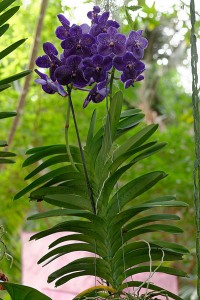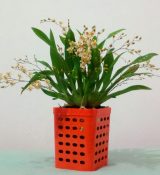A Brief Overview of the Genus Vanda
Author: Celeste Booth2 Comments

Vanda orchids (pronounced VAN-dah) are gloriously brilliant plants, producing colorful round flowers, that can reach 5 inches wide on long profuse spikes. These plants love high-light. Vandas with lots of aerial roots grow exceptionally well undisturbed in baskets. Vanda plants, not bred with any other species of orchid, can reach heights of up to 10 feet high. Bright, hot southern window exposures are perfect, and a spot where the plants can be watered and fertilized freely and abundantly is ideal.
Naming and Distribution
The name comes from the Sanskrit name for Vanda tesselata. Vanda orchids can be found growing throughout much of Asia.
Plant Identification
Vandas are monopodial orchids, meaning that they grow straight up from one point. Their flowers come in array of colors and can be patterned or solid. They bloom every few months for a couple weeks at a time. There are three categories of Vandas based on the shape of their leaves. They are: terete (rounded, pencil-like leaves), semi-terete (in between), and strap-leaved (broader, flat leaves).
 General Care Requirements
General Care Requirements
LIGHT: Terete Vandas prefer full sun, whereas semi-terete prefer slightly less light, and strap-leaved Vandas even less.
TEMPERATURE: Best temperatures are a maximum of 95ºF during the day, and 60-70ºF at night.
WATER: Water thoroughly, yet make sure that the roots dry fast. Water less frequently during winter months.
POTTING: You should repot your orchid in the spring. Only repot if necessary and do not overpot.
Header image via Wikimedia Commons
Secondary image via Wikimedia Commons
2 Responses to “A Brief Overview of the Genus Vanda”
Leave a Reply


Ask an Expert
Questions about orchids?
Our experts love a challenge!
Photo of the Week
Submit your photo to be featured on the blog!
More Photo of the Week Winners
Submit Photo








My Vanda Orchid has not been blooming for almost two years now however they keep on producing new leaves and new roots everytime but does bloom. First year they were out in the direct sunlight and now now they are in the greenhouse for almost a year. I f
I give them the fertilizer and Blom buster every one week but doest flowet
If it is in a place with a very steady temperature, you can try decreasing the temp a bit at night to encourage budding.